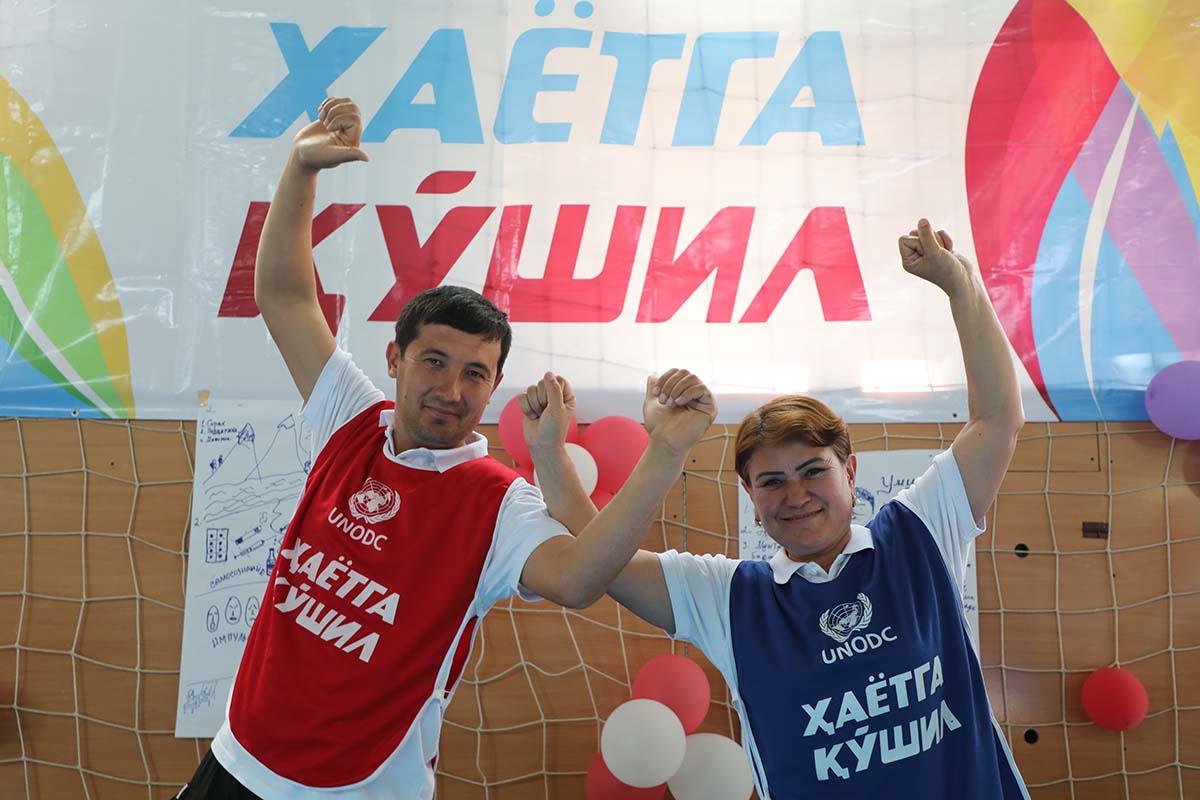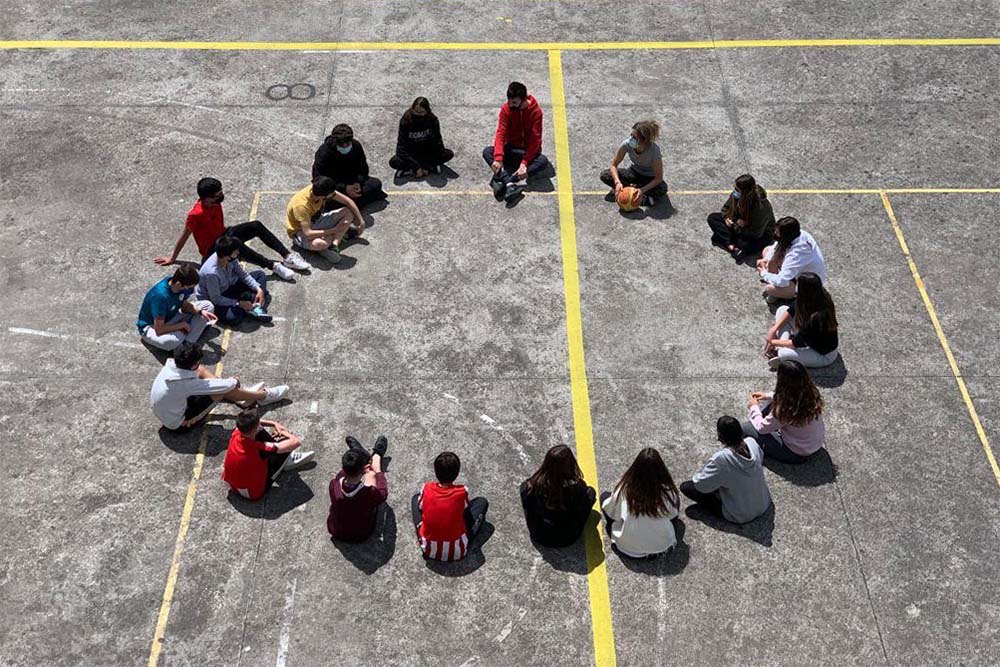UNODC’s new Line Up Live Up publication unveils four years of data and research, showcasing sport as a critical tool for youth crime prevention

22 January 2021 – When international experts gathered at UNODC’s headquarters in Vienna back in 2016 to develop a sport-based intervention that would help reduce youth crime and drug use, the guiding principle was that it had to be informed by existing evidence on what did and did not work. Building on this, and recognizing the evidence about the benefits of developing life skills among youth, UNODC created the Line Up Live Up curriculum. A first for UNODC, this 10-session programme combined sports activities with life skills training for youth aged 13 to 18. Some four years later, the programme has now been piloted in 12 countries across Africa, Central Asia, Europe, Latin America and the Caribbean, and the Middle East and North Africa, building life skills among more than 13,000 youth and working with 900-plus trainers. To ensure accessibility, UNODC implements Line Up Live Up in a variety of settings, including schools, community centres, sport clubs and juvenile facilities, working in close partnership with multiple actors at national and local levels.
Analysing achievements and lessons learned – not only about implementing Line Up Live Up, but also more generally about the use of sport for youth crime prevention – is a central component of UNODC’s work in this area. This not only ensures the initiative can be continuously tweaked and improved upon, but it is also aligned with the recently adopted General Assembly resolution 74/170 on Integrating sport into youth crime prevention and criminal justice strategies, which requested UNODC to share good practices on the effective use of sport in the context of crime prevention.
With this in mind, the Office has been analysing the large amount of data on the implementation of Line Up Live Up, collected since the initiative began in 2016. This also includes two in-depth studies conducted in communities in Brazil and South Africa, both of which followed a quasi-experimental design.
To make these findings as widely accessible as possible, the assessment has been captured in a brand new publication, Youth Crime Prevention through Sport: Insights from the UNODC Line Up Live Up Pilot Programme. The publication places the findings of the Line Up Live Up implementation within the broader context of existing research on the use of sport for youth crime, violence and drug use prevention, and provides recommendations for policymakers and practitioners who seek to use sport to effectively further these goals.
Line Up Live Up performance and sustainability
The assessment looks at the programme’s performance across five key areas: relevance; quality and effectiveness; programme climate; sustainability; and whether the programme was implemented as designed and intended.
Based on self-reporting data, youth participants indicated that the programme is relevant to their needs – 97 per cent of youth surveyed (3,490) either agreed or strongly agreed that they learned new skills for use in everyday life. The assessment also showed that the programme achieved short-term outcomes, including youth feeling supported and motivated to engage in the programme and learn skills; enhanced interaction and relationships with others; and improved personal and pro-social life skills.
 Regarding programme climate – whether there was a welcoming atmosphere and a conducive environment – 99 per cent of those youth participants surveyed agreed that they had a positive relationship with their trainer. This is a key achievement considering the importance of the coach-participant relationship in influencing outcomes, and the role a coach plays in ensuring a conducive climate.
Regarding programme climate – whether there was a welcoming atmosphere and a conducive environment – 99 per cent of those youth participants surveyed agreed that they had a positive relationship with their trainer. This is a key achievement considering the importance of the coach-participant relationship in influencing outcomes, and the role a coach plays in ensuring a conducive climate.
When looking at sustainability, the assessment noted that the connection of Line Up Live Up to relevant national and local policies, plans and strategies had been evident. While recognizing that more can be done, there are several examples of where various states have integrated the programme into existing crime or substance use prevention frameworks and youth programmes. In Kyrgyzstan, for instance, the programme has been incorporated into the training curriculum of the State Sport Academy, and is being introduced into the secondary school curriculum, thus enabling scalability. The programme has also been influential at an institutional level, strengthening and establishing relationships within and beyond Government, alliances, partnerships and intersectoral collaboration. In Peru, for instance, the programme is integrated into the broader local crime prevention strategy, Barrio Seguro (Safe Neighbourhoods).
In short, the assessment of Line Up Live Up reinforces the potential of sport in youth crime prevention.
Recommendations
Building on the Line Up Live Up assessment, several recommendations to maximize the impact of the programme and of other sport -based interventions to address youth victimization, violence and crime were noted, including:
- Integrating sport programmes in broader crime prevention policies and linking them to complementary interventions, such as on positive parenting, mentoring, and employability, which allows them to scale up and sustain results;
- Ensuring the intentional design of programmes to address specific risks and protective factors, including developing a clear theory of change of what the intervention aims to achieve and how this can be done;
- Tailoring the design on sports programmes to the delivery setting (e.g. schools, sport clubs, community centres, juvenile facilities) and the broader implementation context, considering, for example, community violence rates, and to the target audience in terms of risk level of participants, gender, age and other variables;
- Investing in enhancing capacity for programme delivery, especially among trainers given their key role as mentors for youth and continue youth and trainer engagement beyond the project timeline through support programmes and complementary activities;
- Ensuring regular and robust programme assessments, including the need to build capacity for Monitoring and Evaluation and data analysis within organizations;
- Sustaining programme results over time by ensuring local ownership, leadership and support, as well as contextualization and adaptation of programmes to the language, culture and realities of communities; and
- Awareness-raising and buy-in of communities for sport-based approaches, including describing sports programmes using positive narrative, such as empowering rather than as ‘crime prevention’ activities in order to avoid stigmatization.
Launching the publication, and presenting the global evidence on the impact of sport for youth crime prevention, UNODC this week organized an event featuring international experts from State entities, academia and civil society who shared their perspectives with a virtual audience of over 350 participants. During the discussion, experts from academia delved into the existing research regarding the impact of using sport for violence prevention, highlighting the importance of setting realistic goals, measuring impact, and striking the right balance between adapting programmes to the local context and adhering to the design methodology. On their part, representatives from Jamaica, South Africa, and civil society shared their experiences of turning research findings into action-based strategies and programmes, and the challenges they faced along the way. Key solutions proposed to counter challenges in achieving impact and sustaining results included working collaboratively with cross-sectoral partners instead of trying to scale up programmes alone, ensuring dedication to high-quality implementation, and bringing positive role models to share their success stories at the community level for better youth and community engagement. The potential of sport as a cost-effective intervention to prevent violence and increase social capital was also a key takeaway point.
As highlighted by participants, one of the major challenges currently experienced by countries around the world is the difficulty in implementing face-to-face sports programmes during COVID-19. Adaptation to new modes of delivery and creative thinking will be critical to continue delivering sport programmes without leaving behind those lacking internet access. At the closing of the event, Marco Teixeira, Coordinator of the Global Programme for the Implementation of the Doha Declaration, reiterated “UNODC’s commitment to supporting Governments in making the world a safer place, and to engage and invest in young people through sport and other effective, innovative and youth-friendly approaches.”
Despite the challenges and complexities of using sport to prevent youth crime and violence, it is clear that it can offer an effective means of engaging and empowering young people. UNODC will continue to support Member States and civil society in building youth and community resilience through sport, and to ensure that our efforts are based on and contribute to the global evidence-base.
Additional information:
Full publication: Insights from the UNODC Line Up Live Up Pilot Programme


